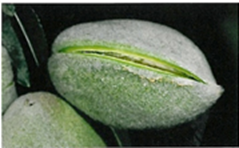Evie Smith, UCCE SRA, South Sacramento Valley.
Franz Niederholzer, UCCE Orchard Advisor, Colusa, Sutter and Yuba Cos.
Katherine Jarvis-Shean, UCCE Orchard Advisor Yolo, Solano, & Sacramento Cos.
Luke Milliron, UCCE Orchard Advisor, Butte, Glenn and Tehama Cos.
Please note that the following are general recommendations intended to help you keep track of regular practices in a busy time; the optimal timing for management practices may vary based on specific location and conditions.
- Navel Orangeworm (NOW) & Peach Twig Borer (PTB): Continue monitoring for NOW and PTB to determine when and how to manage these pests in your orchard. Consider an edge spray when sound nuts in edge Nonpareil nuts reach hull split Stage 2C and a full spray once nuts in the upper canopy of trees within the orchard reach that same stage. Apply a second hull split spray prior to harvest as needed. See our article on Navel Orangeworm Considerations for more information. Consult with your PCA when making decisions about NOW and PTB management.

Stage 2C of hull split. This is the critical time for NOW insecticide and Rhizopus hull rot fungicide applications. The orchard is ready for harvest when all nuts are at Stage 2C.
- Mites: Leaf drop at harvest due to mite damage can lead to fewer flowers next year and slower drying this year. Start monitoring for mites and mite predators throughout your orchard on a weekly basis in July. For more monitoring and treatment information, see the UC IPM site for mites in almonds.
- Ants: Monitor for protein feeding ants and consult with your PCA about ant bait materials and application timing. See the article on ant control in this newsletter.
- Regulated Deficit Irrigation (RDI): RDI can promote earlier, more even hull split in a normal rainfall year. This can help with navel orangeworm and hull rot control in your orchard. However, using this practice in already water stressed trees may contribute to further yield reduction. At the start of hull split, use pressure chamber measurements to check to see if the stem water potential (SWP) of your trees is already in the RDI target range (-14 to -18 bars). If SWP is above -14 bars (for example, -12 bars), there might be some water savings in reducing irrigation, slightly, so that SWP is below -14 bars, but not below -18 bars. Hold SWP in that range for two weeks during initial hull split and then return full irrigation (to 100% ETc) for the last two weeks of hull split leading up to harvest. As stated above, this is a risky strategy in a drought year and should be approached very cautiously.
- Leaf Samples: Take July leaf samples and send them in for analysis to plan your nutrition program for next season, and monitor for potential impacts of using lower quality water during lean water times. Learn more about July leaf analysis sampling procedure and interpretation see this article from The Almond Doctor about leaf analysis and salinity monitoring.


Leave a Reply